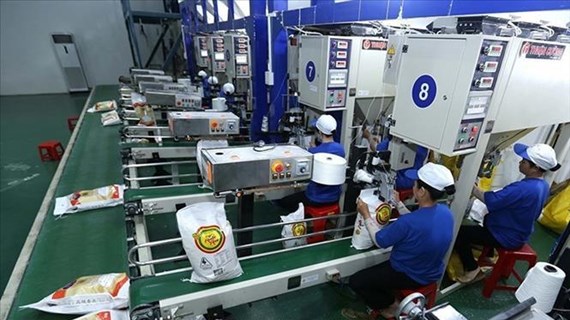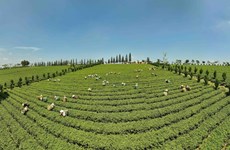Agricultural sector enjoys trade surplus
Vietnam enjoyed a trade surplus in agricultural, forestry and seafood
exports last year while the increase in prices on the world market had
an impact on export value but not added value or the quantity of
exported products, exporters have said.
In 2011, the agricultural, forestry and seafood sector gained a trade surplus of 9 billion USD and opened new export markets, according to the Ministry of Agriculture and Rural Development.
In 2011, the agricultural, forestry and seafood sector gained a trade surplus of 9 billion USD and opened new export markets, according to the Ministry of Agriculture and Rural Development.
Vietnam enjoyed a trade surplus in agricultural, forestry and seafood
exports last year while the increase in prices on the world market had
an impact on export value but not added value or the quantity of
exported products, exporters have said.
In 2011, the agricultural, forestry and seafood sector gained a trade surplus of 9 billion USD and opened new export markets, according to the Ministry of Agriculture and Rural Development.
The sector enjoyed a year-on-year increase of 27 percent to 25 billion USD in exports.
Growth in export value was mainly due to a surge in export prices while the volume of most products reduced slightly against the previous year, the ministry reported.
Only rice and rubber experienced increases in export volume last year at 4.4 percent and 8.2 percent, respectively, while the export volume of coffee stood at the same rate as the previous year and exports of other agricultural products, including tea, rice, pepper and cashews, fell.
Meanwhile, export prices of all agricultural, forestry and seafood products surged to the highest rate of 66.3 percent for pepper and the lowest increase of 9.1 percent for rice.
Do Thuc, head of the General Statistics Office, said two-thirds of export value growth was the result of export price and volume increases.
Growth of the nation's export value could not be based on the agricultural sector because the increase in export value for this sector was not optimistic in 2011 due to the limited availablity of local raw materials for export processing, Thuc told the Thoi bao Kinh te Vietnam (VnEconomy) newspaper.
Advantages in export prices pushed the value up by 33.2 percent to 13.7 billion USD for agricultural products, by 21 percent to 6.1 billion USD for seafood products and 12.7 percent to 4.1 billion USD for forestry products.
However, total export value in the three sectors made up 26 percent of the total national export value in 2011, falling from 26.5 percent in 2010.
In 2012, the agricultural sector is likely to face more difficulty in exporting its products because rice must compete with low-priced rice from India and Pakistan. Seafood exports will be focused on shrimp and tra catfish while rubber will be dependent on the Chinese market, which should account for 60 percent of Vietnam's total rubber export value. Raw material outputs are expected for tea, cashews and coffee./.
In 2011, the agricultural, forestry and seafood sector gained a trade surplus of 9 billion USD and opened new export markets, according to the Ministry of Agriculture and Rural Development.
The sector enjoyed a year-on-year increase of 27 percent to 25 billion USD in exports.
Growth in export value was mainly due to a surge in export prices while the volume of most products reduced slightly against the previous year, the ministry reported.
Only rice and rubber experienced increases in export volume last year at 4.4 percent and 8.2 percent, respectively, while the export volume of coffee stood at the same rate as the previous year and exports of other agricultural products, including tea, rice, pepper and cashews, fell.
Meanwhile, export prices of all agricultural, forestry and seafood products surged to the highest rate of 66.3 percent for pepper and the lowest increase of 9.1 percent for rice.
Do Thuc, head of the General Statistics Office, said two-thirds of export value growth was the result of export price and volume increases.
Growth of the nation's export value could not be based on the agricultural sector because the increase in export value for this sector was not optimistic in 2011 due to the limited availablity of local raw materials for export processing, Thuc told the Thoi bao Kinh te Vietnam (VnEconomy) newspaper.
Advantages in export prices pushed the value up by 33.2 percent to 13.7 billion USD for agricultural products, by 21 percent to 6.1 billion USD for seafood products and 12.7 percent to 4.1 billion USD for forestry products.
However, total export value in the three sectors made up 26 percent of the total national export value in 2011, falling from 26.5 percent in 2010.
In 2012, the agricultural sector is likely to face more difficulty in exporting its products because rice must compete with low-priced rice from India and Pakistan. Seafood exports will be focused on shrimp and tra catfish while rubber will be dependent on the Chinese market, which should account for 60 percent of Vietnam's total rubber export value. Raw material outputs are expected for tea, cashews and coffee./.












